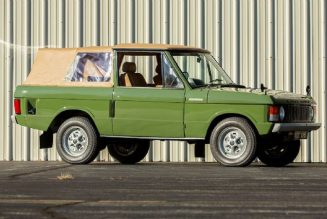Thirty-five years after it was mercifully euthanized, the Chevrolet Chevette remains synonymous with crappy motoring. The Chevette may have been humble and horrible, but it was also one of the most significant cars in General Motors history. It marked a major turning point in GM’s fortunes, the company’s first acknowledgement that the world was changing in ways it didn’t yet understand.
Chevrolet Chevette: Cure for a Corporate Emergency
Like the rest of Detroit, GM had steadfastly avoided making subcompact cars—”Mini-cars, mini-profits,” as Henry Ford II so eloquently put it—but the 1973-74 energy crisis changed all that. GM’s corporate average fuel economy was 12 mpg, worst in the industry. Big car sales dried up instantly and General Motors’ market share dropped to 42 percent, lowest since World War II.
“We were in deep trouble,” GM chairman Pete Estes later recounted. “It was an emergency as far as we were concerned, and we decided we had to move fast, just like a war.” None of the smaller cars in GM’s product pipeline could be ready in time for the 1976 model year, so GM took steps that were unprecedented in its corporate history.
The first departure from the norm was the decision to build a small, basic car. Why was that so remarkable? Because up until now, GM simply didn’t do basic cars. Alfred Sloan had built GM into the world’s largest and most powerful corporation specifically by making nicer alternatives to Henry Ford’s basic cars. GM’s previous import fighters, the Corvair and Vega, were small but not basic, with styling and technology designed to position them above the imports rather than competing head-on.
A Problem That Detroit Couldn’t Solve
The second monumental decision was to use a foreign design. GM was already importing Opels from Germany and Chevrolet LUV pickups from Isuzu, but these were small vehicles intended for fringe buyers. The new small car was to be a major player in GM’s strategy, and it was unheard of that such a significant car should have its genesis anywhere but Detroit.
GM turned to a project known as the T-car, which was nearing completion of its development by Opel and GM do Brasil. The T was supposed to be GM’s first “world car.” First conceived at a 1970 meeting of GM’s overseas division—a meeting that took place in Detroit, of course—the T would launch in Brazil as the Chevrolet Chevette, then spread to Europe (Opel Kadett/Vauxhall Chevette), Argentina (Opel K180), Japan (Isuzu Gemini), South Korea (Saehan Gemini), and Australia (Holden Gemini), with each version customized for each market. As originally conceived, the only part of the world where the “world car” would not appear was the part of the world GM called home.
The crash decision to transform the foreign T-car into a Chevrolet was a surprise to all, even GM internals. When the first blueprints arrived in Detroit, no one could read them as everything was written in German and Portuguese. We at MotorTrend were so intrigued (and surprised) at the Chevette’s origin story that we featured it on our cover for the October 1975 issue.
Having been badly stung by the quality problems of the Chevrolet Vega, GM assigned John Mowrey, who had worked with Isuzu in Japan on its version of the T-car, as the chief engineer for the Chevrolet Chevette. The American version was reworked from bumper-to-bumper, particularly to avoid the Vega’s rust problems, and it was made ready in a remarkably short 18 months.
Chevette Is a Contender—Briefly
While the Chevette’s rear-wheel-drive and solid rear axle sound archaic to modern car fans, the contemporary Datsun B210 and Toyota Corolla used similar architecture The Chevette did have some novel engineering features, including progressive-rate rear springs and an overhead-camshaft engine. Chevrolet developed 1.4- and 1.6-liter versions of 52 and 60 horsepower respectively. The larger engine was contrived in the vain hopes of running an air conditioner and an automatic transmission, the latter the specially developed (and soon-to-be-dreaded) Turbo Hydramatic THM-200.
The 1976 Chevette hit Chevy dealerships in 1975, with the stripped-down two-seat Chevette Scooter listing for $2,899, $500 less than the cheapest Nova. We pitted a Chevette against the market-leading Datsun B210 and the new-and-novel Renault 5, and it proved competitive, if not stellar. The Chevette’s 1.6-liter engine was excruciatingly slow: 0-60 took 19.7 seconds, while the Datsun and Renault did it in the low 17s. Acceleration was hampered by our test car’s 4.11:1 rear axle, which necessitated shifting up to fourth gear to make 60, but the low gearing couldn’t help its agonizing 50-70 passing time of 17.1 seconds.
Handling was stable and competent—the Chevette’s front suspension would later be used on the sporty Pontiac Fiero—though we noted that Detroit had managed to bleach out much of the German ride and handling magic from the chassis. Still, we judged the Chevrolet Chevette to be an adequate alternative to the imports. More importantly, we noted, it was a tacit acknowledgement by General Motors that the American car market was changing rapidly.
The Industry Strikes Back
Sales were cooler than expected as the end of the energy crises bought an unexpected surge in big-car sales. Even so, GM’s competitors were rapidly introducing Chevette competitors. Volkswagen introduced the front-wheel-drive Rabbit to the US in 1976. Ford began importing the European-market Fiesta in 1977. Chrysler followed GM’s lead, partnering with its European subsidiary to develop the 1978 Dodge Omni and Plymouth Horizon, the first modern front-wheel-drive subcompacts built in America.
Chevrolet introduced a three-inch-longer four-door variant for 1978, and refinements to the powertrain and gearing (and elimination of the pitiful 1.4-liter engine) made the Chevette a (slightly) more palatable prospect. The four-door, four-speed Chevette we tested for our July 1978 issue made 60 mph in 15.8 seconds, topped out at 85, and was good fun in the curves, though rather loose if pushed hard. But it was those extra doors the public really wanted: 1978 sales more than doubled to 299,000, greater than Omni, Horizon and Fiesta combined. The second oil crisis in ’79 fueled sales further, and the Chevette had its best-ever year in 1980, with 451,000 sales.
Chevette: From Daring to Dated
But a rash of new imported competitors, not to mention GM’s revolutionary (and ultimately disastrous) front-wheel-drive X-cars, were starting to make the Chevette look like the Homo erectus of cheap motoring. While we might previously have described its platform as traditional, in 1981—first year for Ford’s front-drive Escort—we switched to the word primitive.
“Five-plus years after its debut,” we wrote in June, 1981, “the design is looking positively antique alongside its modern competition. The dated Chevette cannot last many more years, but it is successfully serving a vital stand-in role until GM’s next-generation subcompacts can be readied.”
We were wrong on both counts. The Chevette lasted another half-decade and that next generation of subcompacts never materialized. Instead, GM concentrated on front-wheel-drive replacements for its larger and more profitable cars, while the Chevette soldered on with little more than a facelift and the addition of an unpopular (and even slower) diesel. In July of 1982, we ran a ten-car Econosport comparison test, and the Chevette came in tenth place.
“The Chevette was the only car to foster unanimity,” we wrote. “Every tester placed it dead last in subjective evaluations for its lack of interior space, dated design, minimal instrumentation, poor shifting, and lack of power.” It was the last time the Chevette would be featured in a MotorTrend article for nearly forty years—until now.
Life After the Expiration Date
Two years later, in our August 1984 issue, we tested the Chevette’s supposed replacement, a rebadged Suzuki called the Chevrolet Sprint (which would later morph into the Geo Metro). Like the Chevette, the Sprint was a humble car carrying a monumental message: GM was admitting defeat by sourcing a car from its vanquishing enemy, the Japanese. We paid the Sprint the highest complement we could come up with: “It’s certainly no Chevette.”
The Chevette, however, did not die the quiet death we expected. Sales had been diving steadily since 1981, but took a sudden uptick in ’84. This may have been down to the sharp new CS model, or it may have been a little accounting trickery, as GM reportedly extended the Chevette’s ’84 model year in order to improve its corporate average fuel economy numbers. The end finally came in 1987.
By this time, the Chevette had become well established as a symbol of down-on-your-luck driving. Chevrolet built nearly 2.8 million Chevettes in its dozen-year run, and their garden-tractor mechanicals made them annoyingly durable. Chevettes continued to make their owners miserable well into the 1990s and beyond.
That the Chevette’s legacy would be one of motoring misery is almost a shame. The Chevette is a rarity among malaise-era vehicles in that it is not a victim of its own hubris, but rather that of everyone and everything around it. The Chevette was never supposed to be a great car. It was designed with mediocrity in mind, and mediocrity is exactly what it reliably delivered—for far too long, unfortunately.
And yet the Chevrolet Chevette, set in its proper historical context, is the small pin on which the world’s largest corporation pivoted. It was a major change for a company that seemed unchangeable and a harbinger of the industry’s future. Too bad it was such a lousy car.










